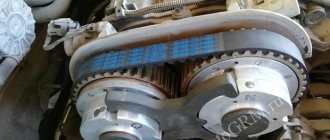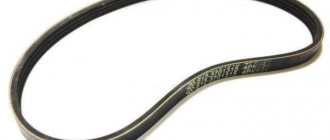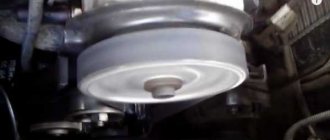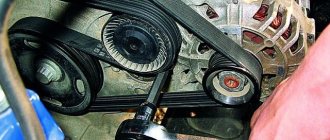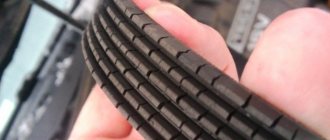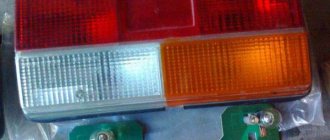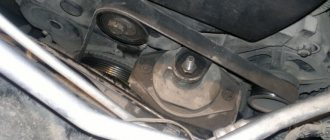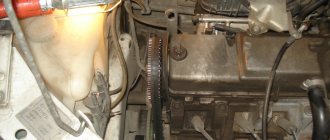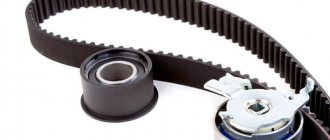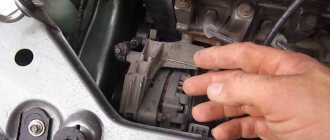The main causes of timing belt breakage
Many car enthusiasts believe that if the timing belt breaks, the main reason is its wear and untimely replacement.
In fact, this is a common mistake, since there are many more reasons for the break. Among the main reasons are the following:
- untimely replacement due to time/mileage;
- errors during operation and maintenance of the vehicle;
- low quality belt;
If everything is clear with mileage and natural aging of the belt, other reasons are not so obvious.
First of all, if the timing belt breaks, the break can be caused by incorrect belt tension, errors when installing the protective casing, jammed rollers or pump, etc. In this case, the belt either simply frays, or when the roller jams, a sharp tension occurs, which leads to the belt breaking
It is important that the belt is tensioned correctly and that the timing belt tensioner is in good condition.
Please note that loosening may cause the belt to jump off the pulley grooves. At the same time, too much tension will lead to active wear and increase the risk of breakage.
For these reasons, it is important to promptly check the timing belt tension, as well as check the condition of all elements (rollers, pulleys, tensioners, etc.). If engine oil or other technical fluids (for example, antifreeze) get on the surface of the belt, this also explains why the timing belt broke
Please note that if oil is found on the surface, the belt must be changed immediately!
If engine oil or other technical fluids (for example, antifreeze) get on the surface of the belt, this also explains why the timing belt broke. Please note that if oil is found on the surface, the belt must be changed immediately!
Ignoring this rule leads to the fact that the belt may begin to slip, and there is a high probability of it jumping off the pulley and breaking. By the way, you should not try to wipe off oil or antifreeze from the surface of the belt for further use. The fact is that engine, transmission and other oils, as well as coolants, are quickly absorbed into the rubber and actively destroy the rubber structure of the belt, leading to the formation of cracks, etc.
Ignoring visible belt defects or using cheap replacement products also often leads to the belt breaking, completely unexpectedly.
For example, a cheap timing belt of poor quality or a counterfeit of the “original” means that you should not count on the declared service life. In practice, a low-quality timing belt may not last even 20 thousand kilometers, after which it quickly delaminates and breaks.
If, upon inspection, external damage and defects are visible on the belt (cracks, delamination of the end part, cavities and depressions, etc.), even a high-quality belt cannot be used any longer. Under moderate to high load conditions, a small crack will quickly grow larger and cause a rupture.
Aggressive driving, high loads, operating a car in difficult conditions (including climatic conditions with strong temperature changes), frequent attempts to start the engine from a pusher, interruptions in the operation of the engine or gearbox (strong jerks when driving) and a number of other similar factors significantly shorten the life of the timing belt.
Even if the belt is visually in good condition, there is a risk of hidden cord rupture. For this reason, it is better to reduce the replacement interval by 20-30% (the belt is replaced every 35-40 thousand kilometers, and not every 50-60 thousand).
Reasons why valve bends
The following main reasons can be identified:
- Condition of the timing belt (cracks, worn teeth, the belt is overtightened or loose)
- Failure to comply with the timing of belt replacement (high mileage of the vehicle).
- Entry of a foreign body (check that the protective cover is installed correctly)
On what cars do valves bend?
On most cars, when the timing belt breaks, the problem of valve bending occurs. It doesn’t even matter whether the engine is idling or driving along the highway. They can still bend. It is important exactly how much the gear is turned when the belt breaks. The bend can occur at 8, 16 and 20 cells. engines, on diesel and gasoline engines, small cars and cars with large displacement. Therefore, it is very important to promptly replace the timing belt. But a timing belt break does not always lead to bending.
On what cars does the valve not bend?
Some engines have small protection - grooves, which are small notches. These grooves are installed so that at high speeds the piston does not catch up with the closing valve. But when the timing belt breaks, they also help reduce the negative consequences, and in some cases they do not bend the valve at all.
Sometimes car owners grind them themselves, but this is not always correct. Since the presence of these recesses leads to a decrease in the engine, an increase in fuel consumption, and the content of nitrogen oxides in the exhaust gases. Many auto companies have now abandoned such protection.
The most reliable method of combating valve bending is timely replacement of the belt.
AvtoVAZ
On the Samara model (VAZ 2108–21099), which are currently out of production, engines designated VAZ 21081, 2108, 21091 do not damage the valves when the timing belt breaks.
On models of the tenth family - VAZ 2110–2112, the general markings of engines that do not bend valves are VAZ-2110 8 class, 2112 and 21124.
In Samara-2, which includes VAZ 2113–2115, engines 2111 and 21124 are also considered risk-free.
"Lada Grante" and "Lada Kalina" are not in danger with the engine version 11183.
"Audi", "Volkswagen", "Skoda" with VAG engine
Cars with a VAG engine with characteristics 1.6 EZ, 1.8 - with markings RP, AAM, PF, PL, AGU, EV, ABS, as well as 2.0 2E, JS are protected from valve deformation.
"BMW", "Opel"
| Brand | Motor marking |
| "BMW" | N46, H46 with 4-cylinder petrol engine. |
| "Opel" | 13S, 13N/NB, 16SN, C16NZ, 16SV, X16SZ, X16SZR, 18E, C18NZ, 18SEN, 20SEN, C20NE, X20SE. Cadet 1.3, 1.6, 1.8, 2.0 l 8 grade. |
"Peugeot"
In French Peugeots with the following engines, the valves are not deformed, but the rocker bars break off:
- 607 2.2 hdi 133 l. With. – the car stalls without any suspicious sounds;
- Bokher 4 НV, 4 НY.
"Ford"
Owners of American Ford cars with zetek 2.0 l and Sierra 2.0 CL OHC 8 cl. There is no need to worry about the valves in a timing emergency.
Chinese: “Gili”, “Lifan”
| Brand | Engine model and/or marking |
| "Gili" | SK/MK 1.5 5A-FE, MK 1.6 4A-FU, FC 1.8 7A-FE, LC 1.3 8A-FE. |
| "Lifan" | LF479Q3 1.3 l, Tritec 1.6 l, 4A-FE 1.6 l, 5A-FE 1.5 l, 1.8 l 7A-FE. |
"Daewoo"
| Model | Engine capacity |
| "Lanos", Sens | 1,3 |
| "Nexia", Uzbekistan | 1.6, 16 cl. |
| "Nexia" G15MF until 2008 | 1.5, 8 cl. |
What to do to prevent the valve from bending if the timing belt breaks
To ensure that the valve does not bend, it is necessary to monitor the condition of the timing belt. It is necessary to change it according to the dates specified in the service book (approximately 60–70 thousand km). But it is also necessary to periodically perform a visual inspection of the belt, even if the replacement period has not come. Quite often, the belt breaks immediately after its installation after 1000–2000 km. This happens if the work to replace it is done poorly.
Periodically remove the cover and check the belt. Inspect it from the outside, check the belt ribs and the presence of microcracks. And also it should not be too tight. Carry out such inspections from time to time. As soon as you see signs of wear on the belt, it's time to replace it.
What happens to the engine when the belt breaks?
What happens if you drive with a handbrake and what consequences will arise?
While the car is running, the engine pistons move in a certain direction. The piston moves down during the intake stroke and rises during the exhaust stroke. When the cylinder block is at the top point, each valve must be closed.
When the timing belt is torn, the valve stops rotating and stops. However, the crankshaft rotates and the pistons are directed towards the open valves. After their meeting, the parts bend and become unusable. Regardless of whether the car is idling or in gear, the likelihood that the pistons will knock on the valves and bend them is quite high.
But still, the higher the speed, the worse the likely consequences. In addition to the fact that the valves will be damaged, the pistons may be damaged and the guide bushings may burst.
Breakage of a new timing belt: common causes
Overflowing oil into automatic and manual transmissions: what are the consequences and what to do
Incorrect operation.
A break in the new timing belt may result from improper operation of the entire assembly. For example, when driving, the tensioners, rollers or pump may jam, which will lead to a break in the new timing belt.
Despite the external quality of this part, when a high crankshaft rotation speed is reached, a sharp change in operating conditions can damage it.
To prevent the new timing belt from breaking, you need to carefully monitor its tension. Excessive tightening can also cause part failure. However, by loosening the drive too much, you can get a similar result due to the belt jumping off the pulley grooves.
This situation can also arise if there is existing pulley play. That is why, in order to prevent engine damage, it is necessary not only to change the timing belt in a timely manner, but also to monitor its tension and the proper operation of each element of the mechanism in order to prevent breakage.
Oil getting on the surface.
If you notice traces of oil or antifreeze on the new belt, this means that it needs to be replaced.
If you do not install a new belt, the entire gas distribution mechanism will not work efficiently. The drive will slip, be removed from the pulley, and eventually break.
Don't think that just by wiping off an oil stain you can continue driving without taking any action. It is not possible to completely remove traces of oil from a new drive. After technical fluid gets on it, it is absorbed, depriving the drive of the qualities necessary for proper operation. Only replacing it with a new drive will help here.
Low quality product.
If you saved money by buying a timing belt, then you need to be prepared for the fact that troubles may arise during its operation. This is a case where the stingy pays twice, because a broken new timing belt can lead to high engine repair costs. We recommend purchasing an original drive from a seller whose quality you are confident in.
Car service workers know well how an attempt to save a couple of hundred rubles can result in repairs costing tens of times more. There is nothing surprising here, since a low-quality new timing drive can break without traveling even a couple of tens of thousands of kilometers
Constantly expecting a catch from such an important detail, you worry, which leads to driving mistakes and uncertainty in your own car.
External damage.
If the drive has served you for a long time or it was of poor quality to begin with, it may develop external damage, such as cracks, grooves, loose threads, and the like. These shortcomings cannot be eliminated
If such damage is present, a new drive must be installed as soon as possible.
Ignoring wear can lead to the fact that under load the defect will intensify and a breakage will occur. It is better to anticipate and prevent this situation than to blame yourself later and pay for expensive repairs and a new drive.
Harsh climate and active driving.
In many regions of Russia, the climate is such that the car is regularly exposed to too high or low temperatures. Therefore, car repair and maintenance must be approached with special care. Sudden changes in temperature can affect the wear of the new timing belt, which increases the likelihood of it breaking. In such conditions, it is better to use only original components for repairs and change the drive at the first signs of wear, without waiting for the expiration of the service life declared by the manufacturer.
Failed rollers very quickly lead to abrasion of the surface and the new timing belt breaks.
The purpose of the rollers is to support the drive in a tense position. It is thanks to them that the timing belt does not slip and does not fly off the teeth. If the rollers malfunction, they jam and the new drive quickly fails or breaks.
How does timing belt work?
Let's consider this mechanism in more detail.
The upper part of the cylinder of a modern engine is cramped: there are two or four valves, a spark plug, and a fuel injection nozzle. And the head arch is made low and almost straight to achieve a high degree of compression and increase power. When the timing camshaft unwinds, thanks to special cams with a complex profile, it presses on the valve stem and opens it to release exhaust gases. The camshaft and crankshaft must be synchronized. If the piston goes down, the valves let in the mixture, and when the piston moves up, they close. This creates pressure in the combustion chamber. Next, the candles ignite the mixture, which pushes the piston. This cycle is repeated many times.
In the worst case, the valve stem bends, the guide sleeve is deformed, the valve jams in the open position and sticks with a sharp edge in front of the flat piston cover. From the second and third impact, the piston itself is destroyed, debris crushes the cylinder walls, scratches the surface or causes scuffing.
Much more often, when the timing belt breaks, the valve only bends and stops closing completely, causing the engine to operate unstably and with an unusual ringing sound.
Therefore, it is better not to let the timing belt break, carefully study its condition and install a new one on time, as required by the maintenance regulations.
Possible costs and procedure for replacing a timing belt
Driving on a flat tire: what consequences await the car enthusiast?
One valve costs approximately 1000 rubles. This is the price of the part without other costs. It is quite possible that sixteen valves will have to be replaced.
You will also need to purchase:
- Timing belt or replacement kit, which contains a tensioner and idler pulley.
- Gaskets for intake and exhaust manifolds.
- Cylinder head gaskets and valve covers.
- Mounting bolts.
- If worn, a pump may be required.
To replace it, you need to find a place where there is a lift.
To make a replacement, you need to stock up on the necessary keys, screwdrivers, alignment pins for timing marks, and, if necessary, special tools.
Algorithm for dismantling the old timing belt to install a new one:
- Unscrew the bolts that secure the timing case.
- Unscrew the bolts that secure the crankcase protection.
- Remove the compressor belt. To do this, it is necessary to dismantle, remove the drive and install the compressor in its original place.
- Remove the alternator belt. To de-energize all contacts, you need to remove the terminal located on the battery.
- Unscrew the bolts on the engine and remove the generator, pump pulley and terminal, removing the bolts that hold them in place. It may be necessary to remove the engine mount.
- Remove the cover protecting the timing belt.
- Remove the toothed pulley cover. Remove the faulty timing belt. Install the new drive, tightening the tensioner properly. If the roller mechanism is faulty, it must also be replaced. Then the entire structure must be assembled in reverse order. Different brands of cars have certain design features, although the general principle of operation is the same.
Purpose of timing belts, their types and replacement frequency
Synchronizing the rotation of the engine crankshaft and the camshaft (or shafts, if there are two) of the gas distribution mechanism is the main purpose of the timing belt. The synchronization process itself is to ensure that the camshafts rotate at exactly half the speed of the crankshaft. The location of the timing belt in the gas distribution mechanism is shown in the figure.
From the engine crankshaft pulley, force is transmitted through the belt to the camshaft pulleys, ensuring their rotation at the required speed. In turn, the eccentrics located on the camshafts, through pushers, rocker arms and rods, open or close the valves at strictly defined points in time, thus ensuring the movement of gases in the engine cylinders.
Simply put, it provides a classic scheme for the movement of gases in the engine along the strokes: intake, compression, power stroke and exhaust.
The above scheme using a timing belt has become most widespread in modern engines, due to a number of advantages over camshaft drive schemes via gears (the so-called lower camshaft):
- the belt does not require lubrication, is located outside the cylinder block and is located in a place accessible for diagnosis and replacement;
- Along with the gas distribution mechanism, it is possible to drive other devices, for example, a water pump (pump)
- the rubber base of the belt material ensures quiet operation;
The main disadvantage of timing belts is the risk of rupture and the consequences associated with this.
Causes of timing belt breakage
There are several reasons why the timing belt breaks, and to determine them you need to have at least a little understanding of the structure of the power unit. Often, drivers encounter this problem after replacing a belt or repairing the gas distribution mechanism, which is associated with replacing valve guides.
Existing limit
Modern timing belts have excellent performance characteristics, including service life. For example, in foreign-made cars it can work flawlessly for up to 150 thousand kilometers. But everything has a limit! Over such a long period of time, it simply “wears out” - its thickness decreases, the ability to maintain the required tension decreases, and other performance characteristics are lost. And that's why the belt breaks.
Wear remains the most common cause of belt damage, so experts recommend periodically checking the belt for wear and, if necessary, replacing it. Note that in Russian Ladas the belt can travel much less than approximately 30-50 thousand km, but sometimes the belt breaks after driving only 15,000. Therefore, complaints are often heard from the owners of Priora, Kalina and other models of this plant.
Broken tension rollers
From the names of the parts it is clear that the rollers are intended to provide tension to the timing belt. This prevents it from slipping and jumping off the teeth. In general, a roller is a bearing with a special layer at the top.
As you know, bearings also have a certain service life. The approaching end of its service life is accompanied by a characteristic noise. If the tension bearings are not replaced in a timely manner, they will become “jammed,” which will literally erase the belt belt in a short time.
Late replacement
The service life of modern new products for distribution mechanisms depends on the make of the car and is about 150 thousand kilometers (on older cars this figure is lower - about 70 - 100 thousand / km). If the vehicle is used in low temperature conditions, the service life of the belt is reduced to 60-100 thousand/km. In any case, experts recommend diagnosing the condition of the timing belt at least every 15 thousand kilometers.
Teeth destruction
It happens that there is no break, but the teeth located at the point of engagement with the gears on the shafts break due to severe wear.
In such a situation, there is also nothing positive: the tear in the canvas is not visible, but the car cannot be started, or it starts, but does not work correctly…. But the fact is that under such conditions the ignition “goes wrong”. And here again the timing belt should be replaced.
Pump wedge
The pump “jams” especially often on cars from Russian factories, although this can also happen on any foreign car.
The occurrence of such a problem also often leads to a rupture of the timing belt and requires a prompt solution. Which, for its part, will save the car owner from more serious financial and time costs in the case when the timing belt breaks and this provokes a breakdown of the power unit
Incorrect belt replacement
Errors made when installing the timing belt lead to asynchronous opening and closing of the valves, resulting in reduced engine power. The cause is usually too loose or too high a tension on the shafts. If the replacement of the product was carried out with errors, it may break after 1-2 thousand kilometers.
Characteristic signs of incorrect replacement:
- the product slides to the side;
- cracks have appeared or become noticeable on its surface;
- An unusual sound is heard when the engine is running.
Foreign elements
If foreign elements get into the distribution mechanism (this could be dirt, small stones, engine oil), the camshaft or crankshaft may jam. To avoid this problem, it is necessary to periodically check the protective cover and fastenings.
Quality of spare parts
And another common cause of timing belt breakage is low-quality components. This happens very often, again with domestic Ladas.
Let’s say that after contacting the service and replacing the corresponding “consumables,” you drove only 5 thousand km, and the belt suddenly broke.
Therefore, try to buy timing belt components only from trusted services and stores, or better yet from official dealers of the manufacturer, of which there are plenty today. It is not wise to save on the gas distribution mechanism and its components!
Total
As a conclusion, I would like to note that it is better to refuse cheap components in the timing drive - they will cost more. Well, of course, counterfeit products will be bad here. Therefore, decide in advance on the company whose belt you want to purchase, and carefully study the difference between fakes and the original. Believe me, every company has fakes, so do not neglect this recommendation. The original “goes around” for a long time, and the counterfeit is just sold at that very fifth thousand.
Check points after installing the timing belt - based on the results of the first two or three trips and after 1,000-2,000. During inspection, no delaminations, protruding threads, or violations of tooth geometry should be revealed, and the product itself should be dry.
And finally, if desired, you can turn a “plug-in” motor into a “plug-in” one by installing a repair kit for pistons with recesses. This technique is actively practiced among VAZ drivers.
The alternator belt is broken
On most cars, a broken alternator belt is indicated by a warning light with a battery icon on the instrument panel. It lights up because the battery stops charging. At the same time, the car does not “stall” for some time until the battery is completely drained. Finding this belt is not at all difficult; it is usually located in the most visible place under the hood. It is thanks to the generator belt that rotation is transmitted from the crankshaft to the generator shaft. A broken alternator belt can be caused by the following reasons:
- natural wear of the belt. On average, the alternator belt must be replaced during mileage every 80-140 thousand km. However, it is necessary to take into account the manufacturers' recommendations. For example, on the Lada Vesta the belt is changed after every 15,000 km, and Toyota recommends replacing the alternator belt as necessary, checking its condition every 20 thousand km. Based on our experience, with working units (pulleys, generator, pump), the service life of the generator belt is about 100,000 km. Although, of course, a lot depends on who is the manufacturer of the belt itself...
- defective belt or Chinese manufacturer. More and more often, situations arise when the car owner changed the belt about 5 thousand km ago, and it broke. A thoughtless attempt to save money leads to a sad result. The ratio of the difference in price of a high-quality product to a low-quality product is not commensurate with the possible global consequences.
- malfunction of pulleys, shafts, tensioners. If these components wear out/break, the alternator belt quickly fails. Almost all manufacturers recommend replacing the tensioner rollers when replacing the alternator belt.
- insufficient or excessive belt tension. Incorrect tension adjustment leads to the same consequences as in the case of unit failure. If the tension is insufficient, when the generator belt slips without having a strong enough adhesion to the working surface of the pulley, it overheats, loses elasticity and breaks. In case of excessive tension, the reinforcing fibers gradually stretch and break. A characteristic whistle can indicate that not everything is in order with the belt tension. This usually happens in wet weather.
Is it possible to continue driving after the belt breaks?
Many experts claim that you can continue driving if the alternator belt breaks without consequences for the car until the battery is completely discharged. However, they forget that more and more cars are appearing in which the generator and pump are driven on the same belt, and driving without coolant circulation can lead to engine overheating and very expensive repairs. And besides, modern batteries really don’t like deep discharge. Therefore, if you do not understand how your car works, it is better not to continue driving.
Broken alternator belt, what to do?
Let's consider several solutions:
- Replace the belt yourself if a spare is available and replace it yourself.
- If you have an understanding of what to do and the ability to work with your own hands, you can make a “temporary” belt (for example, from a trouser belt, women’s tights or a “men’s” tie, a piece of rope, etc.), but this is an extreme and temporary solution.
- Contact the comprehensive roadside assistance service "Avtodoctor" and receive a qualified service: either calling a technical assistance vehicle to replace the belt, or evacuation to a service station.
Symptoms of a break
The timing belt is good for everyone, but unlike the whistling alternator belt, it breaks without any signs of it. It’s clear how the engine’s performance changes when the belt breaks - it stalls, which is why the battery icon and oil can light up even on the meager panel, and the accelerator pedal does not respond. This ends the list of safe symptoms of the problem. Yes, they may advise you to crank the engine with the starter and it will definitely not start. But later you will understand that this is fraught and, moreover, in the absence of experience, does not definitely indicate that the belt drive has failed.
This is interesting: Causes of high fuel consumption: solutions to the problem
Due to the actual absence of symptoms of a break, they do not like the belt, knowingly treating it with caution. After all, in fact, you can make sure that it is torn only by opening the plastic timing case or opening the inspection window, if one is provided for by the protection design. If you think about it for a moment, this must be done after every sudden stop of the engine, even if it was caused by an electronics failure. As they say, it's better to be safe...
It is rare that a break is preceded by any squealing or other noise. In this vein, everything usually goes silently.
Reasons for the breakup
The main flaw of the belt on the Priora (we chose it as an example, but there is no fundamental difference with cars that use a similar type of distribution mechanism) is that it is made of rubber. Accordingly, if the belt is not replaced by the end of its life, the rupture will occur spontaneously and it is impossible to predict this moment.
For modern cars, the only problem with a broken belt is the fact that it breaks. On older cars, a torn belt also means that your valves are bent. In new cars, special grooves are made in the pistons for the valves, due to which such an annoying nuisance does not happen. The 16-valve engines on the Priora are exactly like this. On old VAZ 2109 and 99, if your valves are bent, then you will have to spend a lot of money on repairs.
The belt will break due to the following reasons:
- End of service life.
- Oil leaking from under the block head.
- Broken rollers or tensioner.
Wearing the belt before the deadline is the most common mistake of people who operate a 16-valve engine in a Priora. Therefore, in this case, you need to focus on the recommended mileage indicated by the manufacturer, closer to which it is recommended to replace the belt. At the same time, if you do not want the valves to bend, then replace the belt a little before the expected date.
Another problem for engines that have been running for more than a hundred thousand kilometers is oil leakage. According to the regulations, it is recommended to rebuild a 16-valve engine after the first 150 thousand mileage and replace all rubber elements. If the gasket was not replaced on time and oil from under the valve cover or cylinder head flows onto the drive surface, then you are guaranteed to bend the valves soon (if on your engine, in the event of a break, the valves bend. You can find out more information in the documentation for maintenance of your vehicle). When oil gets on the belt, it causes fatigue aging; the rubber becomes unusable and thins out under the influence of an aggressive environment. The consequences will not be long in coming, so oil leaks should also be considered as signs of a rupture.
Another factor that influences the condition of the timing belt is the auxiliary components that ensure the movement of the belt. On a Priora with a 16-valve engine, idler rollers and tensioners are involved in the movement of the belt.
Jammed roller
The condition and normal operation of these mechanisms should also be considered as signs of rupture, since if some auxiliary mechanism jams while driving, the belt will burst
To prevent this from happening and to prevent the valves from bending, you only need to pay attention to the condition of the auxiliary components of the gas distribution mechanism when performing maintenance. If you notice that something is wrong, then refrain from traveling until the corresponding unit is replaced
